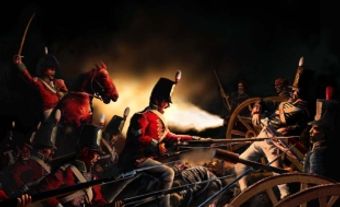
Battle Hill National Historic Site of Canada
Battle Hill National Historic Site, lying on the rolling countryside west of Wardsville, Ont, marks the battleground of a skirmish during the War of 1812 on 4 March 1814 in which a small American force drove off a British attack on their position. The Historic Sites and Monuments Board of Canada designated the site of the Battle of the Longwoods as a national historic site in 1924 and commemorated it with a bronze plaque on a stone cairn in a small park in 1929. The cairn can be seen from Highway 2 but there are no other interpretive facilities. The Upper Thames Military Re-enactment Society holds an annual re-enactment of the battle.
Overview of the Battle of the Longwoods
By November 1813, the Americans were in control of the Detroit River frontier while the British had established small outposts at Port Talbot and the village of Delaware. On 21 February 1814, an American force of 180 mounted regulars and militiamen under the command of Captain Andrew Holmes was sent from Amherstburg to drive the British from that area.
At this time, the British were planning to send a group of First Nations warriors to cross into Michigan to carry a large supply of ammunition to their Aboriginal allies. Part of the plan was for the British to advance down the Thames River to create a diversion. This British detachment would clash with Holmes' force.
The Americans under Holmes arrived at George Ward's farm on Twenty Mile Creek (now Battle Hill Creek) and set up camp on a hill. A small Canadian force of Caldwell's Rangers fired on their position and then hastily retreated. The Americans pursued but discovered that Captain William Caldwell had set up a strong ambush position. They retired back to their position on Ward's Hill, fortifying it with logs and interwoven tree branches.
On learning of Caldwell's skirmish with the Americans, a British force of 130 regulars from the 89th and Royal Scots regiments and about 20 men of the Kent Militia under the command of Captain James Basden were sent to join Caldwell's men to harass the Americans.
Basden planned to attack the American position but waited for a force of First Nations warriors to join his force. Far fewer arrived than expected and finally at 5:00 pm, he sent 50 militiamen and rangers around to the left to attack the Americans from behind and positioned his 28 Aboriginal allies to guard his right flank. He then made a frontal assault with the regulars across a deep ravine and uphill towards the American position. The British came under withering fire and could not reach the Americans. The hill was too slippery and the Americans too well protected in their makeshift fort. Of the 6 British officers in the assault, 2 were killed and 2 severely wounded, including Basden. After suffering heavy casualties of 14 killed and 51 wounded, Ensign Mills of the 89th Regiment, the senior officer still standing, ordered the retreat. The action had lasted for 90 minutes.
While the American casualties were comparatively light, 4 killed and 3 wounded, the skirmish had proven that such a small American force could not take Delaware. By 8:00 pm, Captain Holmes abandoned the hill to retreat to Amherstburg.
The British strategy of creating a diversion to make it easier for a First Nations force to bring ammunition to their allies in Michigan failed. The First Nations warriors, fearful of possible American retaliation against their villages after news of American penetration up the Thames Valley, refused to take the ammunition.

 Share on Facebook
Share on Facebook Share on X
Share on X Share by Email
Share by Email Share on Google Classroom
Share on Google Classroom

